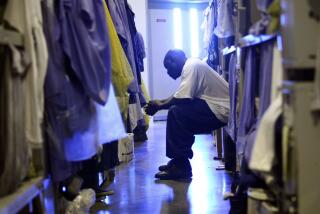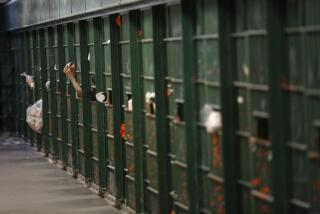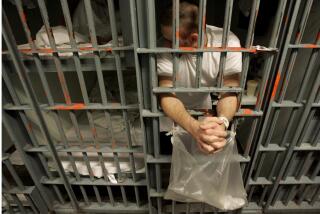Hope for reform of California’s prison system?
California worked at it, worked at it, worked at it, and finally, we did it.
On Monday, the way we jam inmates into prisons was found to meet the constitutional definition of cruel and unusual punishment.
Our achievement here in the Golden State was to incarcerate nearly twice as many people as the prisons were designed to hold, and the amazing thing is that we pulled this off despite building a new prison every year or so. Now, the U.S. Supreme Court, in a 5-4 ruling, has ordered us to thin the herd by 33,000 or so.
The majority opinion called the conditions “appalling” and Justice Anthony M. Kennedy cited “telephone booth-sized cages” and inmates dying of cancer without medical care.
But others warned of disastrous results if inmates are freed, rather than shifted to county facilities, as Gov. Jerry Brown has recommended.
“Terrible things are sure to happen,” wrote Justice Antonin Scalia.
Guess what, Mr. Scalia. Terrible things already did happen. That’s how we got to this point.
We locked up thousands of people for the principal crime of having a mental illness, which is Dark Ages terrible if you ask me. And over the last few decades, with legislative and electoral support for longer and harsher sentences, we’ve built a $10-billion industry in which thousands of people were sent to the state slam for nonviolent drug offenses. It would have been smarter to order them into rehab, and it might have cost taxpayers less. But humane, cost-effective policy doesn’t fit our profile.
Nobody is advocating a get-out-of-jail-free card or a light sentence for hard-core tough guys guilty of assault, robbery, rape or murder. But California took a sharp turn in the other direction, to the point where even a former warden and state corrections chief says we’ve been overzealous when it comes to crime and punishment.
“Prison is for seriously violent individuals,” said Jeanne Woodford, the former corrections chief who’s now with the Earl Warren Institute on Law and Social Policy at UC Berkeley.
Woodford told me California has run an aggressive “catch and release program,” in which we send tens of thousands of parolees back to state prison each year for violations, many of them minor, that could be handled more cheaply and easily at the county level. In her opinion, we incarcerate “many more prisoners than is necessary for the safety of the public.”
But Woodford and others said the Supreme Court decision is cause for hope, because it forces the state to address the situation.
We’ll be getting it wrong if all we do is transfer state inmates to county jails along with a few bucks to cover the costs, said Joshua Page, author of the new book, “The Toughest Beat: Politics, Punishment, and the Prison Officers Union in California.”
“The main thing that got us to this point was increasing the number of people we send to prison and the length of time they stay there,” Page said. His book documents the legendary clout of the prison guards union, which has spent mega-millions of dollars on tough-on-crime campaigns and stuffed the pockets of political candidates — mostly Democrats — who later delivered the goods for the guards.
Page says the prison population has ballooned for a variety of reasons, including three-strikes legislation, the switch to determinate sentencing, the addition of sentencing enhancements and stricter parole requirements.
Unless the state tackles sentencing reforms, Page said, the combined population of prison and jail inmates won’t change much.
Brown’s so-called realignment proposal, still not enacted because of continued squabbling over the proposed extension of temporary tax increases, could satisfy the Supreme Court requirement by transferring as many as 40,000 low-level offenders to county jurisdiction.
Counties would then have more authority to implement sentencing reforms and send offenders to diversionary programs, such as drug and mental health treatment, rather than to jail.
Even if state legislators act, will the concept work?
Woodford worries that we’ll end up with “58 counties doing it 58 different ways,” and local officials are already wondering if the state will pass along enough cash to cover their new responsibilities.
Los Angeles County Superior Court Judge Michael Tynan, who runs diversionary courts for drug offenders and those with mental illness, said it’s not yet clear “how all of this is going to shake out.”
But he’s a big believer in alternative sentencing and hopes there will be more of it as a result of the Supreme Court ruling.
To him, it’s a no-brainer. Although it’s not easy to treat addiction or mental illness, the best policy is to try to help people get better rather than churn them through courts and prisons, punishing them for the conditions that got them into trouble. Actually, a better use of tax dollars would be to treat those conditions before there’s any crime involved, but that’s for another column.
Right now, Tynan said, L.A. County is diverting only about 10% of the defendants who might be better served by diversionary courts.
And even at that, there’s virtually no funding available for new offenders to be sent into drug treatment.
“I’m very grateful for the opportunity to do what I do,” said Tynan, who holds rousing celebrations for defendants who complete rehab requirements in his program and return to work, home and family, rather than joining the teeming masses behind bars.
“I just wish there were more courts doing it.”
More to Read
Sign up for Essential California
The most important California stories and recommendations in your inbox every morning.
You may occasionally receive promotional content from the Los Angeles Times.











